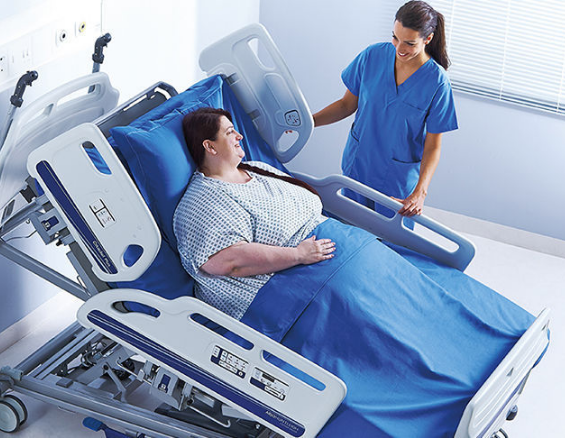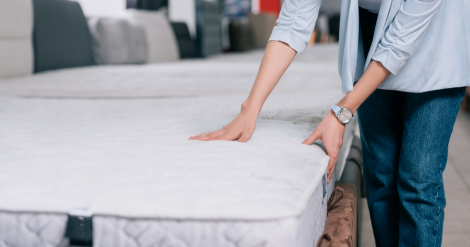No products in the cart.

Bariatric Mattresses That Reduce Decubitus Ulcer Development
The prevalence of obesity has nearly doubled in the last three decades. Nurses practicing in all types of care settings require specialized strategies to care for this patient population. Obese patients have an increased risk of pressure ulcers and maintaining skin integrity is one of the biggest challenges that nurses encounter. This article examines the risk factors for pressure ulcer development in bariatric patients and a review of bariatric mattresses and support surfaces that can prevent skin breakdown in this population.
Risk of Decubitus Ulcer Development for Bariatric Patients
Multiple factors predispose bariatric patients to loss of skin integrity due to changes in their skin physiology. The weight of extra adipose tissue decreases blood and oxygen supply to the skin tissue and perfusion is made worse by impaired vascular tone regulation (1,2,3). Another risk factor is obesity hypoventilation syndrome, which inhibits one’s ability to lie flat, supine or prone. The head of the bed must remain elevated, which can lead to shear injuries as gravity pulls the patient’s torso down towards the foot of the bed (3,4). Finally, adipose tissue insulates the body, trapping heat, increasing body temperature and causing diaphoresis. The result is a warm, moist skin surface that is ideal for growth of microorganisms, particularly Candida albicans (34,5).
Preventing Pressure Sores in the Bariatric Population
A Braden scale assessment should be completed for all bariatric patients to identify their risk for skin breakdown. In particular, the moisture, mobility and friction/shear subscales are predictive of decubitus ulcer development in this population (1,6). Staff must pay special attention to ensure that urinary catheters, IV tubes and drainage bags are not hidden under bariatric patients as severe localized pressure injuries can result (7). Extra wide bariatric hospital beds should be used so that patients can be repositioned and skin will not be pressed against the side rails (8). Likewise, bariatric-sized mattresses are needed to provide comfort and relieve pressure on bony prominences. These therapeutic support surfaces redistribute body weight to help maintain blood flow to high-risk areas and can reduce the incidence of pressure injuries by up to 60% (9).
MedMattress Bari Care Mattresses
Bariatric multi-density foam mattresses are more effective than standard hospital mattresses for preventing decubitus ulcers and less expensive than alternating pressure systems. MedMattress Bari Care mattresses feature high-density, conforming foam layers on top for comfort with high-density foam layers underneath for balanced support. They provide optimal pressure redistribution and skin protection for patients who weigh up to 1,000 lbs. The top cover has low-shear nylon to reduce friction as it minimizes heat and moisture buildup between the skin and mattress. A secondary fluid barrier ensures that the foam core remains dry and sanitary even if the outer cover is compromised. The MedMattress Bari Ultra Care mattress is appropriate for bariatric patients who are at higher risk for skin breakdown. It has the same features of the Bari Care mattress with an additional top layer of cool-gel memory foam to wick heat away from the patient’s body. All Bari Care mattresses are appropriate for acute care facilities as well as long term care and home settings.
Conclusion
Providing bariatric patients with supportive multi-density foam mattresses can greatly improve comfort and help prevent development of painful decubitus ulcers. MedMattress carefully crafted Bari Care mattresses for patients who weigh 500 – 1,000 lbs and are at moderate to high risk for skin breakdown. They are an economical alternative to alternating pressure mattresses. The MedMattress team is ready to help facilities balance cost and functionality while protecting their patients from pressure injuries.
References
- Berrios, L. (2016). The ABCDs of managing morbidly obese patients in intensive care units. Critical Care Nurse, 36(5), 17-26.
- Cowdell, F. & Radley, K. (2014) Skin hygiene for patients with bariatric needs. Nursing Times, 110(24), 22-23.
- Rush, A. (2009). Bariatric care: Pressure ulcer prevention. Wound Essentials, 4, 68-74.
- Clark, L. & Black, J. (2011). Keeping the bariatric patient’s skin intact. Bariatric Times, 8(5), 20–23.
- Earlam, A. (2020). Obesity: Skin issues and skinfold management. Retrieved from https://www.myamericannurse.com/obesity-skin-issues-and-skinfold-management/
- Swanson, M., Rose, M., Baker, G., Drake, D., … Waters, W. (2011). Braden subscales and their relationship to the prevalence of pressure ulcers in hospitalized obese patients. Bariatric Nursing and Surgical Patient Care, 6(1), 21-23.
- Haugen, V. (2015). Prevention of pressure ulcers due to medical devices. Perspectives, 10(3), 1-11.
- Blackett, A., Gallagher, S., Dugan, S., Gates, J., … Lutze, J. (2011). Caring for persons with bariatric health care issues. Journal of Wound Ostomy & Continence Nursing, 38(2), 133-138.
- McNicol, L., Mackey, D., Watts, C., & Zuecca, N. (2020). Choosing a support surface for pressure injury prevention and treatment. Nursing 2021, 50(2), 41-44.
You might also be interested in:

-
/
Rest for Success: When to Bid Adieu to Your Old Mattress
Rest for Success: When to Bid Adieu to Your Old Mattress We spend about a third of our lives in bed, and the quality of our sleep directly impacts our overall well-being. One often overlooked factor in achieving a good night’s sleep is the condition of our mattress. As the years go by, our faithful […]
Read more
Unveiling the Truth: Busting Common Mattress Myths
Unveiling the Truth: Busting Common Mattress Myths A good night’s sleep is crucial for overall well-being, and the right mattress plays a pivotal role in achieving that. However, amidst the quest for the perfect mattress, numerous misconceptions have caused mattress shoppers confusion when searching for the right mattress. Our latest blog unravels the truth behind […]
Read more
-
/
How Medical Bed Mattresses Aid in Post-Surgery Recovery
How Medical Bed Mattresses Aid in Post-Surgery Recovery Surgery can be a daunting experience, regardless of its nature or severity. The period following a surgical procedure, known as post-surgery recovery, is crucial for achieving the best possible outcome. While factors like rest, nutrition and pain management are widely acknowledged as vital, the role that medical […]
Read more
-
/
Meeting Medical Mattress Quality Standards
Meeting Medical Mattress Quality Standards Medical mattresses are designed to meet specific quality standards to ensure patient safety, comfort and hygiene. These standards are established to address the unique needs of healthcare environments as well as the patients utilizing these mattresses. Some key quality standards for medical mattresses include: Infection Control Standards Water […]
Read more